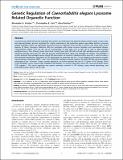Genetic Regulation of Caenorhabditis elegans Lysosome Related Organelle Function
Author(s)
Soukas, Alexander A.; Carr, Christopher E.; Ruvkun, Gary
DownloadSoukas-2013-Genetic Regulation o.pdf (1.831Mb)
PUBLISHER_CC
Publisher with Creative Commons License
Creative Commons Attribution
Terms of use
Metadata
Show full item recordAbstract
Lysosomes are membrane-bound organelles that contain acid hydrolases that degrade cellular proteins, lipids, nucleic acids, and oligosaccharides, and are important for cellular maintenance and protection against age-related decline. Lysosome related organelles (LROs) are specialized lysosomes found in organisms from humans to worms, and share many of the features of classic lysosomes. Defective LROs are associated with human immune disorders and neurological disease. Caenorhabditis elegans LROs are the site of concentration of vital dyes such as Nile red as well as age-associated autofluorescence. Even though certain short-lived mutants have high LRO Nile red and high autofluorescence, and other long-lived mutants have low LRO Nile red and low autofluorescence, these two biologies are distinct. We identified a genetic pathway that modulates aging-related LRO phenotypes via serotonin signaling and the gene kat-1, which encodes a mitochondrial ketothiolase. Regulation of LRO phenotypes by serotonin and kat-1 in turn depend on the proton-coupled, transmembrane transporter SKAT-1. skat-1 loss of function mutations strongly suppress the high LRO Nile red accumulation phenotype of kat-1 mutation. Using a systems approach, we further analyzed the role of 571 genes in LRO biology. These results highlight a gene network that modulates LRO biology in a manner dependent upon the conserved protein kinase TOR complex 2. The results implicate new genetic pathways involved in LRO biology, aging related physiology, and potentially human diseases of the LRO.
Date issued
2013-10Department
Massachusetts Institute of Technology. Department of Earth, Atmospheric, and Planetary SciencesJournal
PLoS Genetics
Publisher
Public Library of Science
Citation
Soukas, Alexander A., Christopher E. Carr, and Gary Ruvkun. “Genetic Regulation of Caenorhabditis elegans Lysosome Related Organelle Function.” Edited by Stuart K. Kim. PLoS Genetics 9, no. 10 (October 24, 2013): e1003908.
Version: Final published version
ISSN
1553-7404
1553-7390